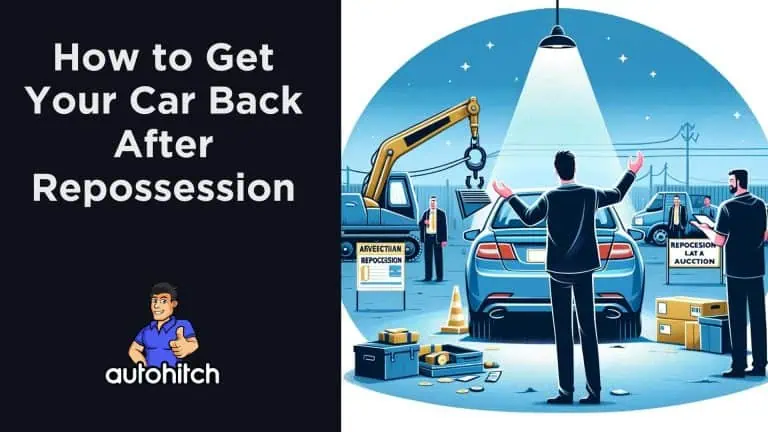If you’re reading this, you have likely just had your car repoed and are wondering how to get your car back after repossession.
Fortunately, there are options for getting your car back, but you must act quickly.
I created the guide below, which will cover everything you need to know, from preventing repossession in the first place to buying back your car at auction if it has already been taken.
Relevant Articles To Read:
- What Happens If You Hide Your Car From Repossession
- The Complete Guide to Car Repossession
- Can I file For Bankruptcy And Keep My Car
- Car Repossession Loopholes
Table of Contents
Can You Get a Repossessed Car Back?
Yes, in many cases, you can get your car back after it has been repossessed. The key is acting fast and understanding all your options:
- Reinstate the Loan: Ask your lender for a “Reinstatement Quote.” Bring your loan current by paying the past-due amount plus repossession costs like towing and storage fees. You typically have 10-20 days to pay after repossession.
- Redeem the Loan: Pay off the entire remaining balance on your auto loan, including all repossession costs.
- Buy Back at Auction: Bid on and repurchase your vehicle if the lender decides to sell it at auction.
You’ll need to gather funds quickly to pursue these options. Evaluate whether you can realistically afford future car expenses before deciding.
What Happens in the Repossession Process?
When you miss loan payments, the lender can hire a repossession company to take your car without warning. Agents may take vehicles from driveways or public parking lots when unlocked. They cannot breach the peace by forcing entry into locked locations.
Once repossessed, the lender can either keep the car or sell it to recoup losses. They must notify you of intentions to sell. You may receive:
- Acceleration Notice: Lender informs you the loan is in default and they intend to sell the vehicle. You’d have to pay the balance to stop auction.
- Opportunity to Cure Notice: Outlines the steps and deadline for you to redeem the vehicle and avoid sale.
- Sales Notice: Provides auction time/place if sold publicly or sale date if private party.
Repossession Costs to Understand
If your car gets repossessed and sold, you may still owe additional money, known as a “deficiency balance.” This includes:
- Remaining loan balance
- Missed payments
- Repossession costs like towing/storage
- Interest and late fees
The lender might also charge off remaining deficiency balances owed or engage collections agencies. This can severely hurt your credit if unpaid.
Getting Personal Property Back After Repossession
Check your state’s laws regarding reclaiming personal possessions left inside repossessed vehicles. Most states require reasonable, cost-free access but some enable storage fees.
Follow these steps:
- Inventory: Make a detailed list of items left inside with values
- Contact Lender: Ask about process for retrieving personal belongings
- Schedule Pickup: Arrange date/time to get your items
- Inspect Condition: Note any damage to possessions when collected
What Are Your Rights in Repossession?
Laws prohibit repossession agents from using physical threats/force. Other protections include:
- Cannot take items inside the vehicle as compensation
- Must inventory and allow retrieval of personal property
- Forced entry into locked locations is illegal
- Damage/harm to property during repossession may warrant compensation
If you believe your rights were violated, consult consumer protection resources.
Alternatives to Repossession
If you’re struggling with payments, immediately contact your lender explaining the situation. Possibilities to avoid repossession include:
- Payment plan modifications or deferments
- Partial lump-sum payments
- Loan restructuring with lower monthly costs
- Refinancing approval contingencies
Voluntary repossession (Giving the car back) is also an option, but it still damages your credit. Try all alternatives before resorting to voluntary repossession.
Improving Your Credit After Repossession
A repossession stays on your credit report for up to 7 years. To recover, focus on:
- Making all other payments on time
- Paying down debts swiftly
- Limiting new credit accounts opened
- Disputed any errors on your credit report
This steady financial commitment over time will help improve your credit standing so that your scores will rebound faster when the repossession falls off your profile in the future.
Recovering a repossessed car requires swift action on your part, but can be done if you understand the process fully. Be aware of the consumer rights protections in your state, recognize any additional costs you may owe, and carefully consider all options for getting your vehicle back or paying outstanding debts.
Speaking with a financial advisor or consumer attorney would also be something I highly recommend if you can afford it.
Sources For this Article
- https://www.justia.com/debt-management/car-repossessions/getting-your-car-back-after-repossession/
- https://www.consumerfinance.gov/ask-cfpb/what-happens-if-my-car-is-repossessed-en-865/
- https://consumer.ftc.gov/articles/vehicle-repossession
- https://www.bankrate.com/loans/auto-loans/auto-loan-charge-off/
- https://www.lendingtree.com/auto/how-to-negotiate-car-payoff/



